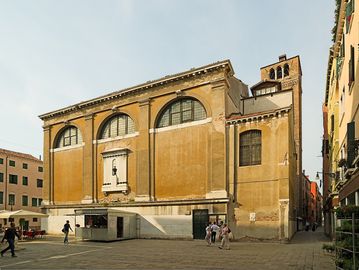

The church is named after St. Cassian, a 4th century schoolmaster and martyr from Imola, the town near Bologna that today boasts the world-famous Formula One racetrack. It is said that when he refused to sacrifice to the Roman gods, Emperor Julian handed him over to his students, who cut him up with their styli, their sharp writing instruments.
The present-day church was built in the 14th century and then reconstructed in the 17th, although a shrine had stood on this site since 726. Its exterior is unimposing; you can pass this campo and not even notice it. However, inside, hidden amidst all the baroque pomp and extravagance, we can find several jewels of Venetian painting. The most famous is Jacopo Tintoretto's Crucifixion of Christ, which renowned English art historian John Ruskin called "the finest example of crucifixion painting in Europe." It is located in the chancel, along with two other Tintoretto works: the Resurrection and the Descent into Limbo. The church's ceiling, depicting the Glory of St. Cassian, was painted by a student of Gianbattista Tiepolo, Costantino Cedini. The altar is a work of German sculptor Heinrich Meyring, who was the most sought after sculptor in Venice in the beginning of the 18th century.
But the most mysterious artwork associated with the Church of St. Cassian was the Sacred Conversation altarpiece, painted in 1476 by Sicilian painter Antonello da Messina. Messina influenced a host of Venetian artists: Bellini, Giorgione, Vivarini, even Titian. Unfortunately, the altarpiece disappeared from the church in the 17th century and somehow, in unclear circumstances, was discovered in the private collection of the Austrian Archduke. However, by the time it reappeared, pieces had been broken and it was cracked. Today the altarpiece can be seen, or at least its remaining parts, in the Kunsthistorisches Museum in Vienna. Ah, that inexplicable power of art!